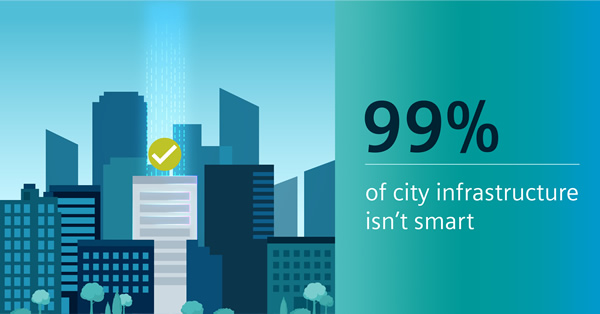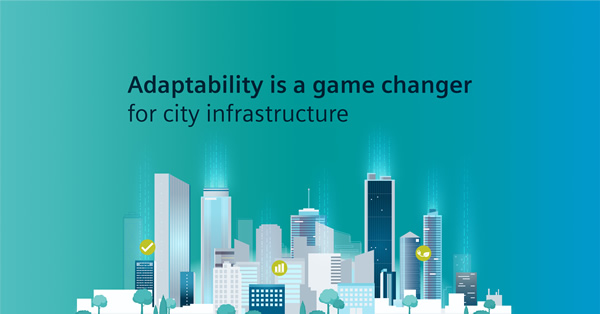
By Cedrik Neike, Siemens Smart Infrastructure.
The coronavirus pandemic is a new experience for every one of us. It has changed life as we know it – at work, at home and for public interactions. As some countries start to ease restrictions on public life, how can we go back to ‘normal’ while still maintaining social distancing and feeling safe? How do we manage crowded public spaces such as shopping malls, cinemas and restaurants? How do we optimise safety in our offices and factories? More importantly, how do we avoid shutting down entire cities and countries when the next pandemic hits?
Whilst the crisis raises many questions, it also forces us to reflect on how our cities can be more human-centric and resilient in the face of unforeseeable challenges. Many would argue that there are very few, if any, human-centric cities in the world. Reasons for this include air pollution, poor urban planning and traffic congestion, to name a few. However, despite the chaos of the past months, I am convinced that there is a silver lining – it is in adaptability. It is now clearer than ever, that the main characteristic of our future cities needs to be adaptability.

Adaptability – the game changer
The pandemic has given our environment a much-needed breather, but it hasn’t removed the biggest challenges we are up against. Our resources are still finite, and using them efficiently, so we can live sustainably on this planet, remains a top priority. Today, we have a golden opportunity to reassess how technology can be applied to tackle the challenges of climate change, urbanisation and population growth. The pandemic is creating a paradigm shift: we are on the cusp of a leapfrog into a new era of digitalisation.
Whilst 99% of city infrastructure remains dumb today, technologically speaking, digitalisation can make it more flexible and quicker to respond to crises. Digitalisation allows us to create a digital, adaptable twin of a city in the virtual world. We can test and simulate a city’s resiliency to events like natural disasters and pandemics. This helps us understand how adaptable it is to such events and simulate a number of responses to activate in the future.
Our goal should be to create cities that balance environmental impact and economic growth. While natural resources continue to dwindle, data is an infinite resource at our disposal. Data is at the heart of digitalisation. Using it can help us achieve this goal by eliminating waste and saving energy and cost. We are already doing that in buildings – and getting better at it. But leveraging data to the advantage of people in cities is still at its infancy. In the future, we envisage smart infrastructure becoming all-sensing; an ecosystem that knows you and adapts to your needs, thanks to data and digitalisation.

This process is continuous in the sense that we should create an infinity loop, with constant improvement based on the connection from the physical and virtual worlds. It’s like children whose brains develop based on sensory experience – gaining knowledge through feedback from senses or others; learning not to touch something hot, for example. The infinity loop for infrastructure connects input from all the sensors and experts in order to continuously improve the experience of those in the city and enhance the value of solutions for customers.
All-sensing infrastructure
Sensors make all-sensing infrastructure possible. They are used almost everywhere today, from detecting earthquakes, measuring your heart rate on a fitness tracker to ensuring safety of workers on industrial sites. Data collected through these sensors is sent to a computer to be analysed and used intelligently.
The significance of sensors is growing, and is only going to increase after this pandemic, with intelligent sensors contributing more to our public and private lives. This is because they allow us to monitor our surroundings like never before. The challenge is to create an ecosystem by joining all the dots.
Today, through our subsidiary Enlighted, IoT smart sensors collect and monitor real-time occupancy, light levels, temperatures and energy use. They can distinguish between people and objects and customise controls for specific purposes. There are 3.5 million sensors installed across our customers’ buildings globally, helping them to make the best use of their office space and cut energy costs. In the UK, they enable an NHS (National Health Service) outpatient facility to cut energy spend by 80% annually.
Smart sensors are also useful in case of a fire – giving fire-fighters reliable information about the number of people and their location in the building. In other cases, they monitor air pollution, helping cities comply with clean air and emission reduction targets.
In the past, we placed sensors to protect and operate our infrastructure. Now we are extending that to make our environment anticipatory, interactive and caring. We realise that using smart IoT sensors can significantly contribute to secure business continuity during a pandemic.
Possible future applications of sensors
What if a pandemic hits again? Sensors could help us continue to work in the office and meet in public by enabling social distancing. They can quantify the density in any given area at any given time, making sure people keep their distance and avoid overcrowding. This means we may not have to shut entire cities and countries in the future.
We also expect the focus on office space efficiency and utilisation to increase. Different use cases, such as comfort or asset efficiency is something we’ve been looking at for a while. In response to COVID-19, more customers are asking for applications that help them design their offices in more optimal ways. Today, 33% of commercial real estate space is underutilised or unused, creating an opportunity to save cost. Add to this the opportunity for a significant increase in ongoing home working, thanks to the biggest forced test in history, and the potential for reducing real estate costs becomes compelling.
There could be more demand for critical environment applications, for example in pressurised rooms for hospitals and labs. In indoor spaces, often more polluted than outdoors, we can use occupancy data to adjust airflow, so that it circulates better when there is a density of people in one area. This ensures better air circulation in supermarkets, for example.

Imagine coming to the office during a pandemic. How do we ensure infected people stay at home? Sensors can play an important role here by measuring temperature and communicating with access control systems. Workplace apps, such as the Siemens Comfy app, can play a role, allowing people to only book a desk that is two meters apart from the next occupied one.
But more sensors in smart cities also raises important ethical concerns around data privacy – even if our sensors ensure anonymity.
Ethical smart infrastructure
Data privacy is about balancing what is feasible, legal and ethically right. If we want to create all-sensing infrastructure that helps preserve natural resources and tackle global challenges, we need to collect and analyse data. There will be hard choices to make – privacy versus safety, environmental impact and convenience. Individuals have the right to decide what matters to them. We want to make sure our data is used for the limited purpose we signed up to and is not misused. Global companies have a big responsibility to manage data ethically and show transparency about what is stored and for what purpose.
Let’s benefit from what we’ve learned
Our world has changed forever, so let’s create a new normal that benefits from new uses of technology and from the positives of the experiences of lockdown. We must take the time to reflect on what really matters in life and what we want to take forward – more home working, increased virtual collaboration, fewer air miles or flexible working to gain more hours with family.
Data exchange will be key to making our cities more adaptable and resilient to crises. With the right setup, the infrastructure that is most adaptable to change – be it pandemics, natural disasters or climate change – will not only survive but also help society to thrive.
Cedrik Neike is the CEO of Siemens Smart Infrastructure. Siemens Smart Infrastructure (SI) is shaping the market for intelligent, adaptive infrastructure for today and the future, addressing the pressing challenges of urbanization and climate change by connecting energy systems, buildings and industries.











